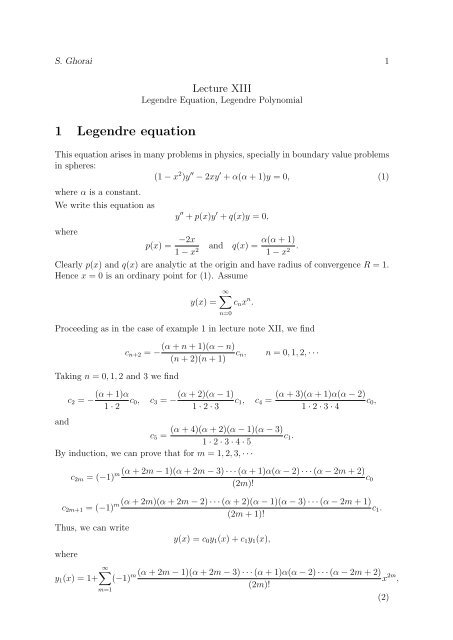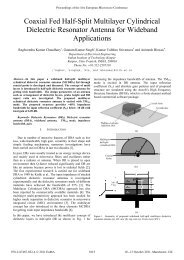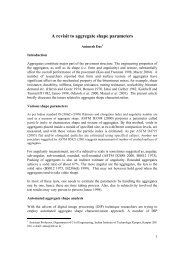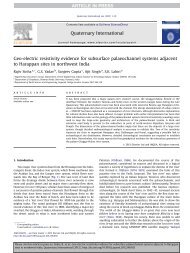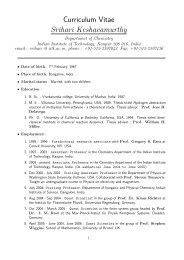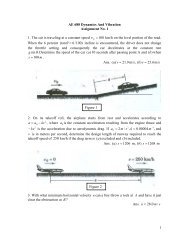1 Legendre equation - iitk.ac.in
1 Legendre equation - iitk.ac.in
1 Legendre equation - iitk.ac.in
You also want an ePaper? Increase the reach of your titles
YUMPU automatically turns print PDFs into web optimized ePapers that Google loves.
S. Ghorai 1<br />
1 <strong>Legendre</strong> <strong>equation</strong><br />
Lecture XIII<br />
<strong>Legendre</strong> Equation, <strong>Legendre</strong> Polynomial<br />
This <strong>equation</strong> arises <strong>in</strong> many problems <strong>in</strong> physics, specially <strong>in</strong> boundary value problems<br />
<strong>in</strong> spheres:<br />
(1 − x 2 )y ′′ − 2xy ′ + α(α + 1)y = 0, (1)<br />
where α is a constant.<br />
We write this <strong>equation</strong> as<br />
where<br />
y ′′ + p(x)y ′ + q(x)y = 0,<br />
p(x) = −2x<br />
1 − x 2 and q(x) =<br />
α(α + 1)<br />
.<br />
1 − x2 Clearly p(x) and q(x) are analytic at the orig<strong>in</strong> and have radius of convergence R = 1.<br />
Hence x = 0 is an ord<strong>in</strong>ary po<strong>in</strong>t for (1). Assume<br />
y(x) =<br />
∞<br />
cnx n .<br />
Proceed<strong>in</strong>g as <strong>in</strong> the case of example 1 <strong>in</strong> lecture note XII, we f<strong>in</strong>d<br />
cn+2 = −<br />
Tak<strong>in</strong>g n = 0, 1, 2 and 3 we f<strong>in</strong>d<br />
c2 = −<br />
n=0<br />
(α + n + 1)(α − n)<br />
cn, n = 0, 1, 2, · · ·<br />
(n + 2)(n + 1)<br />
(α + 1)α<br />
(α + 2)(α − 1)<br />
c0, c3 = − c1, c4 =<br />
1 · 2<br />
1 · 2 · 3<br />
and<br />
(α + 4)(α + 2)(α − 1)(α − 3)<br />
c5 = c1.<br />
1 · 2 · 3 · 4 · 5<br />
By <strong>in</strong>duction, we can prove that for m = 1, 2, 3, · · ·<br />
(α + 3)(α + 1)α(α − 2)<br />
c0,<br />
1 · 2 · 3 · 4<br />
m (α + 2m − 1)(α + 2m − 3) · · · (α + 1)α(α − 2) · · · (α − 2m + 2)<br />
c2m = (−1)<br />
(2m)!<br />
m (α + 2m)(α + 2m − 2) · · · (α + 2)(α − 1)(α − 3) · · · (α − 2m + 1)<br />
c2m+1 = (−1) c1.<br />
(2m + 1)!<br />
Thus, we can write<br />
where<br />
y1(x) = 1+<br />
y(x) = c0y1(x) + c1y1(x),<br />
∞<br />
m (α + 2m − 1)(α + 2m − 3) · · · (α + 1)α(α − 2) · · · (α − 2m + 2)<br />
(−1) x<br />
(2m)!<br />
2m ,<br />
(2)<br />
m=1<br />
c0
S. Ghorai 2<br />
and<br />
∞<br />
m (α + 2m)(α + 2m − 2) · · · (α + 2)(α − 1)(α − 3) · · · (α − 2m + 1)<br />
y2(x) = x+ (−1) x<br />
(2m + 1)!<br />
m=1<br />
2m+1 .<br />
(3)<br />
Tak<strong>in</strong>g c0 = 1, c1 = 0 and c0 = 0, c1 = 0, we f<strong>in</strong>d that y1 and y2 are solutions of<br />
<strong>Legendre</strong> <strong>equation</strong>. Also, these are LI, s<strong>in</strong>ce their Wronskian is nonzero at x = 0. The<br />
series expansion for y1 and y2 may term<strong>in</strong>ate (<strong>in</strong> that case the correspond<strong>in</strong>g solution<br />
has R = ∞), otherwise they have radius of convergence R = 1.<br />
2 <strong>Legendre</strong> polynomial<br />
We note that if α <strong>in</strong> (1) is a nonnegative <strong>in</strong>teger, then either y1 given <strong>in</strong> (2) or y2 given<br />
<strong>in</strong> (3) term<strong>in</strong>ates. Thus, y1 term<strong>in</strong>ates when α = 2m (m = 0, 1, 2, · · ·) is nonnegative<br />
even <strong>in</strong>teger:<br />
y1(x) = 1, (α = 0),<br />
y1(x) = 1 − 3x 2 , (α = 2),<br />
y1(x) = 1 − 10x 2 + 35<br />
3 x4 , (α = 4).<br />
Note that y2 does not term<strong>in</strong>ate when α is a nonnegative even <strong>in</strong>teger.<br />
Similarly, y2 term<strong>in</strong>ates (but y1 does not term<strong>in</strong>ate) when α = 2m + 1 (m = 0, 1, 2, · · ·)<br />
is nonnegative odd <strong>in</strong>teger:<br />
Notice that the polynomial solution of<br />
y2(x) = x, (α = 1),<br />
y2(x) = x − 5<br />
3x3 , (α = 5),<br />
y2(x) = x − 14<br />
3 x2 + 21<br />
5 x5 , (α = 5).<br />
(1 − x 2 )y ′′ − 2xy ′ + n(n + 1)y = 0, (4)<br />
where n is nonnegative <strong>in</strong>teger, is polynomial of degree n. Equation (4) is the same as<br />
(1) with n repl<strong>ac</strong><strong>in</strong>g α.<br />
Def<strong>in</strong>ition 1. The polynomial solution, denoted by Pn(x), of degree n of (4) which<br />
satisfies Pn(1) = 1 is called the <strong>Legendre</strong> polynomial of degree n.<br />
Let ψ be a polynomial of degree n def<strong>in</strong>ed by<br />
ψ(x) = dn<br />
dx n (x2 − 1) n . (5)<br />
Then ψ is a solution of (4). To prove it, we proceed as follows: Assume u(x) = (x 1 −1) n .<br />
Then<br />
(x 2 − 1)u (1) = 2nxu. (6)<br />
Now we take (n + 1)-th derivative of both sides of (6):<br />
<br />
(x 2 − 1)u (1)<br />
(n+1)<br />
= 2n(xu) (n+1) . (7)
S. Ghorai 3<br />
Now we use Leibniz rule for the derivative of product two functions f and g:<br />
(f · g) (m) m<br />
<br />
m<br />
= f<br />
k<br />
(k) g (m−k) ,<br />
which can be proved easily by <strong>in</strong>duction.<br />
Thus from (7) we get<br />
k=0<br />
(x 2 − 1)u (n+2) + 2x(n + 1)u (n+1) + (n + 1)nu (n) = 2n<br />
Simplify<strong>in</strong>g this and not<strong>in</strong>g that ψ = u (n) , we get<br />
(1 − x 2 )ψ ′′ − 2xψ ′ + n(n + 1)ψ = 0.<br />
Thus, ψ satisfies (4). Note that we can write<br />
ψ(x) =<br />
<br />
(x + 1) n (x − 1) n<br />
(n)<br />
where s(x) is a polynomial. Thus, ψ(1) = 2 n n!. Hence,<br />
Pn(x) = 1<br />
2n 1<br />
ψ(x) =<br />
n! 2nn! <br />
xu (n+1) + (n + 1)u (n)<br />
= (x + 1) n n! + (x − 1)s(x),<br />
3 Properties of <strong>Legendre</strong> polynomials<br />
a. Generat<strong>in</strong>g function: The function G(t, x) given by<br />
1<br />
G(t, x) = √<br />
1 − 2xt + t2 d n<br />
<br />
.<br />
dx n (x2 − 1) n . (8)<br />
is called the generat<strong>in</strong>g function of the <strong>Legendre</strong> polynomials. It can be shown<br />
that for small t<br />
1<br />
√<br />
1 − 2xt + t2 =<br />
∞<br />
Pn(x)t n .<br />
b. Orthogonality: The follow<strong>in</strong>g property holds for <strong>Legendre</strong> polynomials:<br />
<br />
1<br />
0, if m = n<br />
Pm(x)Pn(x) dx =<br />
−1<br />
2<br />
,<br />
2n + 1<br />
if m = n.<br />
c. Fourier-<strong>Legendre</strong> series: By us<strong>in</strong>g the orthogonality of <strong>Legendre</strong> polynomials,<br />
any piecewise cont<strong>in</strong>uous function <strong>in</strong> −1 ≤ x ≤ 1 can be expresses <strong>in</strong> terms of<br />
<strong>Legendre</strong> polynomials:<br />
∞<br />
f(x) ∼ cnPn(x),<br />
where<br />
Now<br />
⎧<br />
∞ ⎨<br />
cnPn(x) =<br />
⎩<br />
n=0<br />
cn =<br />
2n + 1<br />
2<br />
n=0<br />
1<br />
−1<br />
n=0<br />
f(x)Pn(x) dx.<br />
f(x), where f is cont<strong>in</strong>uous<br />
f(x− ) + f(x + )<br />
, where f is discont<strong>in</strong>uous<br />
2


